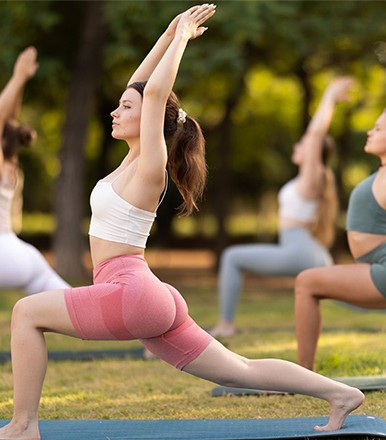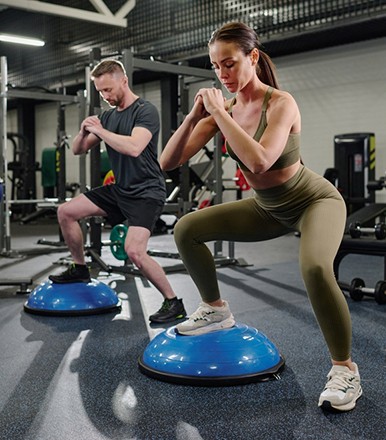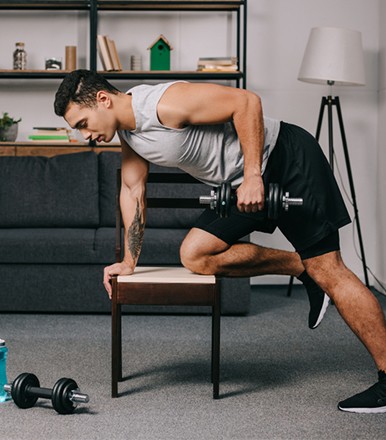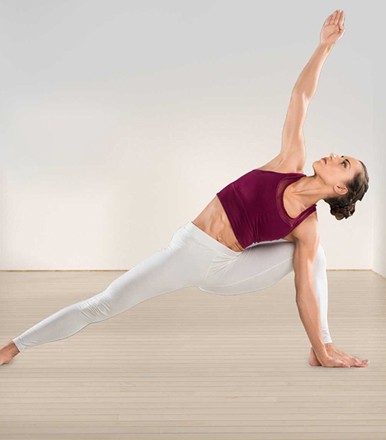The core components of health-related fitness include cardiovascular and muscular endurance, flexibility, and your body’s ratio of fat compared to muscle and bone.
It’s well known that being physically active is important for good health.
We’re told to get our daily steps in, lift some weights, and avoid sitting too much. Yet, it’s hard to know how this relates to health and what being fit means.
This is where the five health-related components of physical fitness can come in handy. Dividing fitness into five categories can help you better design a training program that promotes good health.
This article tells you all you need to know about the five health-related components of fitness, why they’re important, and how to include them in your workout routine.
The basic components of physical fitness explained
While you may know the many benefits of being physically active — like a reduced risk of chronic disease, improved mental health, and better quality of life — you may wonder what being physically fit means.
The five health-related components of physical fitness can be a useful guide to help you achieve physical fitness and promote good health. They describe five areas to focus on in your fitness journey to ensure a well-rounded, active lifestyle.
The five areas of health-related fitness are
- Cardiovascular endurance: the ability to perform exercises at moderate-to-vigorous intensities for a prolonged time.
- Muscular strength: how much force your muscles can exert or how heavy weights they can lift.
- Muscular endurance: the ability of your muscles to sustain exercise for some time.
- Flexibility: the ability to move muscles and joints through a full range of motion.
- Body composition: your body’s ratio of fat mass to fat-free mass like muscle and bone.
Why are they important?
Exercise provides many benefits and supports your health.
Some benefits are immediate, like improved mood, sleep, insulin sensitivity, and blood pressure. Other benefits are noticeable after a few months, like increased muscle mass, strength, flexibility, and lung capacity.
Further, numerous studies have found that being physically fit protects against many diseases and health issues — including heart disease, stroke, type 2 diabetes, osteoporosis, depression, dementia, and certain types of cancer, just to name a few.
Being physically active can also support healthy aging and increase how many healthy, active years you have. For example, strength training into late adulthood can help preserve lean muscle mass, which is a major predictor of falls and quality of life.
Ultimately, living an active lifestyle no matter your age is important for supporting good overall health.
Cardiovascular endurance
Cardiovascular, or cardio, fitness refers to your body’s ability to sustain exercise for longer. It’s also known as cardiorespiratory endurance or aerobic fitness.
Good cardio fitness allows you to perform different activities for longer because your heart and lungs can deliver oxygen and nutrients to your working muscles.
Examples of activities that benefit from good cardio endurance include walking, jogging, swimming, cycling, and other sports that require continuous movement.
It’s recommended that you get 150–300 minutes of moderate-intensity exercise, 75–150 minutes of vigorous-intensity exercise, or a combination of both each week.
Moderate-intensity exercise can be sustained for longer than vigorous-intensity exercise, though exactly how long varies between individuals and their fitness levels.
A good way to test if you’re exercising at moderate intensity is to do the talk test. If you can talk but not sing, you’re likely at moderate intensity. If you can’t even talk without pausing for a breath, you’re likely at a vigorous intensity.
What is moderate intensity for one person may be vigorous for another. Therefore, it’s best to make goals based on your current fitness level.
If you become fatigued or out of breath quickly, decrease the intensity or duration of your exercise and build up from there. Any increase in cardio exercise is beneficial, so make realistic goals that work best for you.
Muscular strength
Muscular strength is the ability of a muscle group to exert force or lift and carry weight. The stronger your muscles, the heavier weight you can lift and move.
Muscular strength can vary between different muscle groups. For example, you may have strong glutes and quads but weaker biceps.
To ensure well-rounded muscular strength, it’s important to prioritize muscular strength training of all major muscle groups like legs, arms, core, shoulders, back, and hips.
To measure your muscular strength, you can test your one-rep max, which is the maximum weight you can lift for one rep.
That said, your one-rep max isn’t the only way to tell if you’re getting stronger. Progressive overload — defined as gradually increasing weight, volume, training frequency, or intensity over time — is another great way to measure your progress.
In addition to building strength, you may want to aim for muscle hypertrophy, or building muscle mass. To do so, aim for 8–12 reps per set. Once you can easily perform 12 reps, increase the weight, as this indicates you’re getting stronger.
If you want to increase your one-rep max, focus on your maximal muscular strength. You can do so by incorporating exercises with heavy weights and low reps — usually 2–6. Make sure you practice proper form to reduce the risk of injury.
Ideally, try to add strength training to your workout program at least 2–3 times per week.
Muscular endurance
Unlike muscular strength, which measures how much weight you can lift or move, muscular endurance tests how long your muscles can withstand an exercise.
In addition to training for muscular strength, make sure you add some muscular endurance activities into your routine, such as:
- Weight training: Instead of aiming for a low rep range, try to lift lighter weights with a higher rep range — like 20 or more reps — until your muscles become fatigued.
- Isometric exercise: This involves holding your body in the same position for an extended period. For example, holding a plank for as long as you can.
- Longer duration training: Using your muscles for long periods, like cycling, running, swimming, or stair climbing, relies on muscular endurance to keep you going. The more you train, the longer your muscles can go before reaching fatigue.
If you’re looking to improve your general endurance, low-intensity bodyweight exercises are a great starting point. For example, pilates, yoga, stair climbing, and long-distance activities are good options.
If you’re looking to improve your athletic performance, consider incorporating higher rep strength training and sport-specific training to increase your muscular endurance.
Flexibility
Flexibility is defined as the range of motion of a joint or group of joints without pain or difficulty.
Being flexible is important for daily living. For instance, it can make it easier to maintain good balance, reach the top shelf of a cupboard, or bend down to pick up something from the ground.
Further, some activities require more flexibility than others, such as gymnastics, dance, and martial arts.
Though there is debate on its benefits in reducing pain and injury risk, stretching can increase your flexibility and may enhance your performance in activities that require you to be more flexible.
When stretching, the goal is to be gentle and limit the risk of injury. Avoid stretching your muscles to the point of extreme discomfort or pain. Aim to do stretching activities at least 2–3 days per week.
To increase your flexibility, there are three types of stretching to utilize:
Static stretching
This involves stretching and holding a muscle for 10–30 seconds.
When stretching this way, your brain relaxes the muscles that support your joints.
While helpful for flexibility, it may increase the risk of injury before activities that rely on joint support, such as weight training or high-intensity sports. Therefore, this type of stretching is generally best reserved for the cool-down phase of a workout.
Dynamic, or active, stretching
These are active movements that take your muscles and joints through a full range of motion.
This is usually done during a warm-up or can be done by itself like during a stretching break at work.
Examples include shoulder rotations, leg swings, walking lunges, and trunk twists.
Dynamic exercises
These include exercises that elongate and stretch the muscle during movements, such as when performing pilates, yoga, tai chi, and barre.
Unlike static stretching, the muscles aren’t held in a single position for a longer period. The purpose of dynamic movement is to wake up the muscles needed for the upcoming exercise.
It’s great to include dynamic stretching in a warmup routine before both endurance and strength training to prepare your body for movement.
Endurance exercises that benefit from dynamic movement include biking, running, and swimming, as well as sports activities like basketball, soccer, and volleyball.
Body composition
Body composition is the last health-related component of fitness. It describes the ratio of fat mass to fat-free mass.
Body fat is essential to human health. However, having too much — especially around the stomach area — has been linked to poorer health and a greater risk of chronic diseases like heart disease, type 2 diabetes, and certain types of cancer.
Meanwhile, having greater muscle and bone mass is linked with improved health outcomes and a lower risk of chronic diseases.
Keep in mind that health looks different for everyone. The below parameters can help you understand your body composition:
- Waist circumference. A larger waist circumference (>35 inches or 85 cm in women and >40 inches or 101.6 cm in men) indicates greater body fat in the stomach area and is linked with a higher risk of chronic disease.
- Waist-to-hip ratio. A high ratio (>0.80 in women and >0.95 in men) is associated with a higher risk of chronic disease.
- Bioelectrical impedance analysis (BIA). A convenient but less accurate measure of body fat percentage. You can find these machines in some fitness centers or purchase at-home BIA scales.
- Dual-Energy X-ray Absorptiometry (DEXA). Performed in clinical settings, DEXA measures bone mineral density, muscle mass, and fat mass. It can give a more accurate idea of your body composition. However, it’s less accessible and can be costly.
- Hydrostatic underwater weighing. This method measures your weight on land and then again underwater using an underwater scale. This method is usually reserved for research settings.
- Air Displacement Plethysmography (ADP) or BodPod. Found in specialty clinics, BodPods measure your total weight, fat mass, and muscle mass. It’s much easier to perform than hydrostatic underwater weighing.
You can also use body mass index (BMI) to give you a general idea of your body composition. However, it’s less specific and rarely paints a true picture of your health.
While body composition is an important component of fitness, it’s not the only one. Focusing on the other four areas of fitness — cardiovascular endurance, flexibility, and muscular strength and endurance — may help you achieve a healthy body composition.
Using the health-related components of physical fitness to design a training program
When designing a training program, it’s important to consider your current fitness level, goals, schedule, and preferences.
Ideally, aim to reach the physical activity guidelines, which include:
- 150–300 minutes of moderate-intensity exercise, 75–150 minutes of vigorous-intensity exercise, or a combination of both every week.
- 2–3 days of muscular strength and endurance training per week.
- at least 2–3 days of stretching and flexibility training per week.
You can assign each component to certain days of the week or incorporate each aspect into a single workout.
For example, you may choose to do strength training on Monday, Wednesday, and Friday, cardio on Tuesday, Thursday, and Saturday, and stretching a few days a week.
Alternatively, you can focus on exercises that incorporate both strength training and cardio, such as high-intensity interval training or boot camps.
Ultimately, the goal is to add each component of fitness into your training program in a way that works for you. With a little trial and error, you’ll be able to find a workout routine that you enjoy and helps you achieve your desired results.
The bottom line
The five health-related components of fitness can work as a useful guide toward achieving physical fitness.
Each of the components — cardio, muscular strength and endurance, flexibility, and body composition — is associated with better physical fitness and overall health.
Though your training plan depends on your fitness goals, it’s a good idea to incorporate a variety of training modalities into your workout routine. This may include some cardio exercises, muscular strength and endurance training, and stretching or dynamic movement.
Since each area is important for health and overall fitness, keep them all in mind when designing your workout program.
Hello Fitness Magazine is your go-to source for the latest in fitness, nutrition, and wellness. Our mission is to inspire and guide individuals on their journey to a healthier lifestyle. With expert advice and practical tips, we aim to make fitness accessible to everyone. Join our community and take the first step towards a healthier, happier you!
Explore Hello Fitness Magazine insights on health, Physical Fitness & Healthy Food Recipes!














